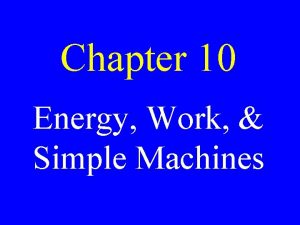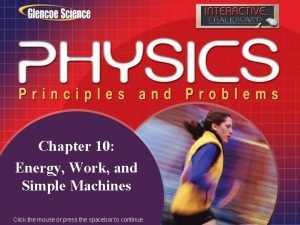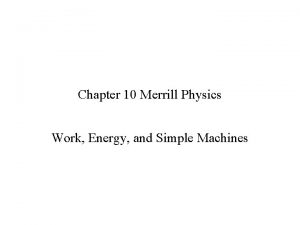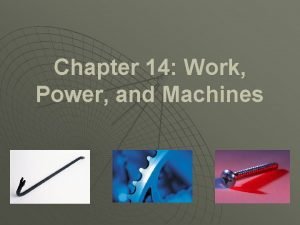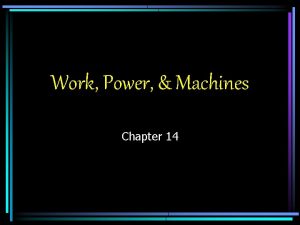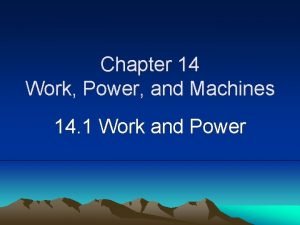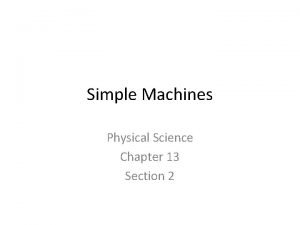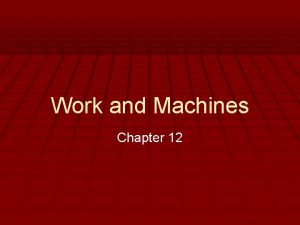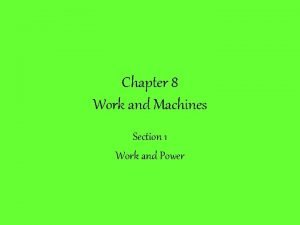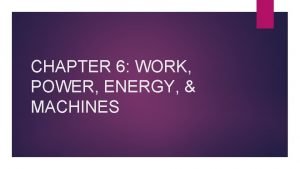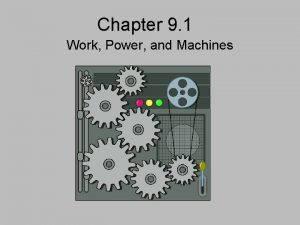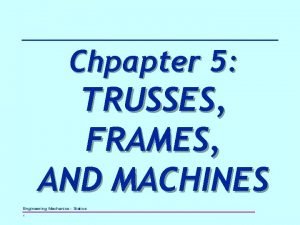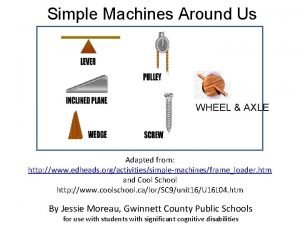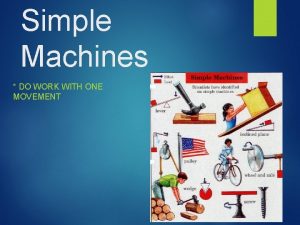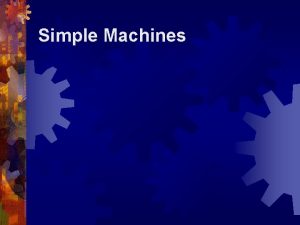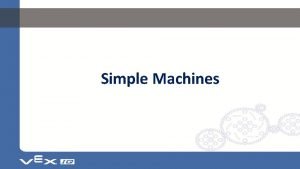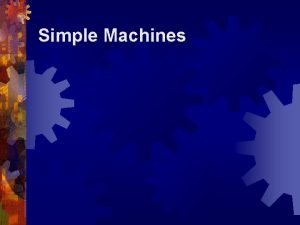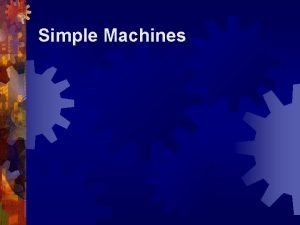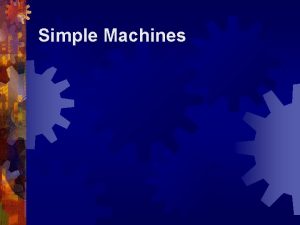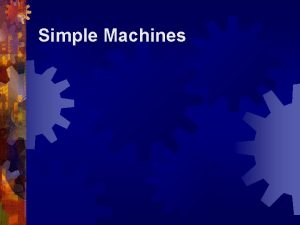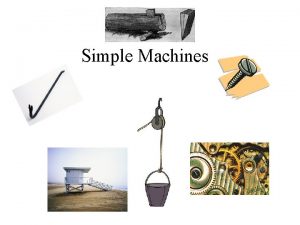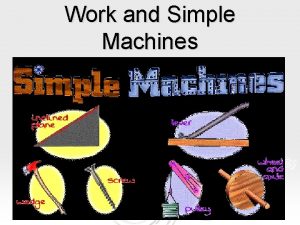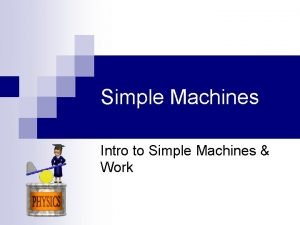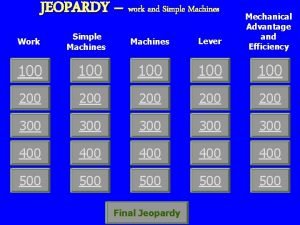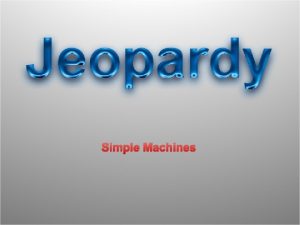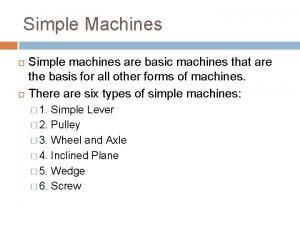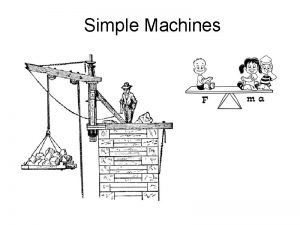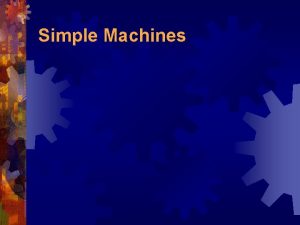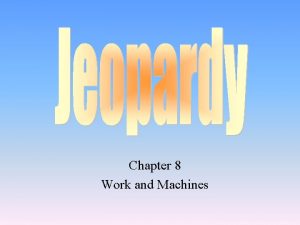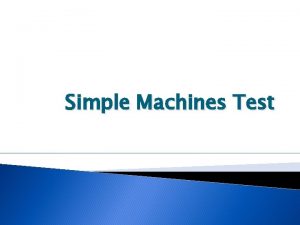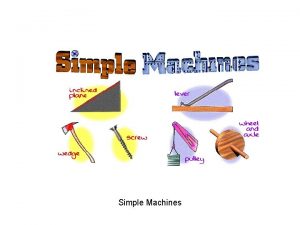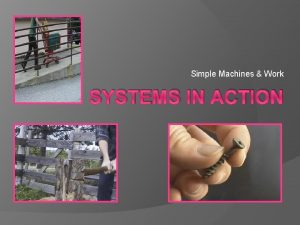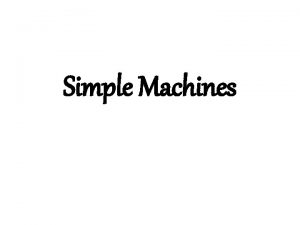Work and Simple Machines Chapter 3 What machines



























- Slides: 27

Work and Simple Machines Chapter 3

What machines do you use in your life to help you do some type of work?

Work- Transfer of energy that occurs when a force makes an object move. - For work to occur, an object must move - the motion of an object must be in the same direction as the applied force on the object

Calculating Work • You must know two things to calculate work- Force and Distance. 1. The Force must be in Newtons. 2. The distance must be in meters. A Newton-meter is also called a joule, which is the unit of work. The work equation uses the distance that the force acts on the object , not the total distance that the object moves. The work done on an object depends on the direction of the force applied and the direction of the motion. The weight of any object is due to the downward force of gravity on the object.

Work and Energy • Work and energy are related, since energy is always transferred from the object doing the work to the object on which the work is done. • Work is done on an object only when the force is being applied to the object and the object moves. • Calculating work- Work equals force multiplied by distance Work(in Joules)= applied force(Newtons) X distance(meters) W=Fd

W=Fd 1. A force of 75 N is exerted on a 45 kg couch and the couch is moved 5 m. How much work is done in moving the couch? 2. A lawn mower is pushed with a force of 80 N. If 12, 000 J of work are done in mowing a lawn, what is the total distance the lawn mower was pushed?

Work and Energy • Doing work on an object transfers energy to the object. • Because doing work on an object requires that the object moves, doing work on the object increases its kinetic energy. • Lifting an object increases the objects gravitational potential energy.

POWER • The amount of work done in a certain amount of time; rate at which work is done - Calculating power- Power equals work divided by time Power(watts)=work(joules) time(seconds) P=W t 1. To lift a baby from a crib 50 j of work is done. How much power is needed if the baby is lifted in 0. 5 s? 2. If a runner’s power is 130 W, how much work is done by the runner in 10 minutes?

USING MACHINES • A device that makes doing work easier is a MACHINE. • Machines increase applied force and/or change direction of applied force to make work easier. - Same amount of work can be done by applying a small force over a long distance as can be done by applying a large force over a short distance, since work equals force times distance. - Increasing distance reduces the amount of force needed to do the work - Some machines change the direction of the applied force to do the work.

Machines can help move things that resist being moved. - Force applied to machine is INPUT FORCE OUTPUT FORCE – resistance. - force applied by a machine to overcome -Amount of energy the machine transfers to the object cannot be greater than the amount of energy transferred to the machine a. some energy transferred is changed to heat due to friction b. An ideal machine with no friction would have the same input work and output work.

Input and output force

Mechanical Advantage (MA) • Is the number of times a machine multiplies the effort force. It is calculated by: MA= resistance force(output) divided by effort force(input)

EFFICENCY • Measure of how much of the work put into a machine is changed into useful output work by the machine. -Calculating efficiencyoutput work divided by input work times 100% - Efficiency of a machine is always less than 100% - Lubricants can make machines more efficient by reducing friction.

SIMPLE MACHINES • A machine that does work with only ONE motion LEVER- a bar that is free to pivot about a fixed point called the fulcrum. -Input arm is part of the lever on which effort force is applied. -Output arm is part of the lever that exerts the resistance force.

Three classes of levers based on positions of effort, force, and fulcrum 1. FIRST CLASS LEVER- fulcrum is located between the effort and resistance forces; multiplies and changes direction of force

Second class lever- resistance force is located between the effort force and fulcrum; always multiplies force.

Third class lever- effort force is between the resistance force and fulcrum; doesn’t multiply force but does not increase distance over which force is applied.

Calculating ideal Mechanical Advantage (IMA) of a lever- IMA equals the length of the input arm divided by the length of output arm

PULLEY • Grooved wheel with a rope, simple chain, or cable. ; running along a groove is a pulley, which is a modified first class lever. 1. A FIXED PULLEY- is attached to something that doesn’t move; force is not multiplied but direction is changed; IMA=1

A MOVEABLE PULLEY- pulley has one end of the rope fixed and the wheel free to move; multiplies force; IMA=2

BLOCK AND TACKLE- system of pulleys consisting of fixed and moveable pulleys; IMA= number of ropes supporting resisting weight

Wheel and Axle- machine with two wheels of different sizes rotating together; modified lever form IMA=radius of wheel divided by the radius of the axle Gears are a modified form of the wheel and axle

INCLINED PLANE- sloping surface that reduces the amount of force required to do work. • IMA= length of slope(effort distance) divided by height of slope(resistance distance) • Less force required if a ramp is longer and less steep

SIMPLE MACHINE IMA Lever Length of input arm __________ Length of output arm Wheel and Axle Inclined Plane Radius of wheel _________ Radius of axle Length of inclined plane __________

Screw- inclined plane wrapped in a spiral around a CYNDRICAL POST Wedge-an inclined plane with one or two sloping sides

Compound Machine- uses a combination of two or more simple machines

 Section 4 review physical science
Section 4 review physical science Energy work and simple machines chapter 10 answers
Energy work and simple machines chapter 10 answers Chapter 10 energy, work and simple machines answer key
Chapter 10 energy, work and simple machines answer key Energy work and simple machines chapter 10 answers
Energy work and simple machines chapter 10 answers Physics 10
Physics 10 Chapter 14 work power and machines
Chapter 14 work power and machines Chapter 14 work power and machines
Chapter 14 work power and machines Chapter 14 work power and machines
Chapter 14 work power and machines Compound machines
Compound machines How does mechanical advantage work
How does mechanical advantage work Section 1 work and machines
Section 1 work and machines Section 2 describing energy worksheet answers
Section 2 describing energy worksheet answers Work power energy and machines
Work power energy and machines A crate of bananas weighing 3000 n
A crate of bananas weighing 3000 n Simple present, simple past, simple future
Simple present, simple past, simple future Les machines simple
Les machines simple Determine the force in each member of the truss.
Determine the force in each member of the truss. Examples of wheel and axels
Examples of wheel and axels Screw simple machines
Screw simple machines How do machines make work easier
How do machines make work easier Machine that does work with only one movement
Machine that does work with only one movement Past simple future simple present simple
Past simple future simple present simple Present simple past simple future simple
Present simple past simple future simple Simple past simple present simple future
Simple past simple present simple future Present continuous past continuous future continuous
Present continuous past continuous future continuous Present past future simple exercises
Present past future simple exercises Tenses chart for class 10th
Tenses chart for class 10th Frases afirmativas simple present
Frases afirmativas simple present


